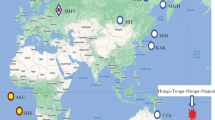Abstract—A mechanism responsible for the transformation of energy of geomagnetic disturbances into the energy of chemically active products is proposed. According to this mechanism, this transformation is implemented by electrolysis at the interfaces between the media with a different type of conduction under the passing of telluric currents induced by the variations of the geomagnetic field. The efficiency of the transformation of disturbance energy into the energy of electrolysis products is estimated. The energy flux absorbed by the Earth under geomagnetic disturbances is estimated. It is shown that the energy transferred to the chemical energy of the products of electrolysis is comparable with seismic energy. It is suggested that chemically active gaseous products of electrolysis affect seismic activity. It is also hypothesized that the electrolysis under the action of telluric currents induced by the variations of the geomagnetic field is one of the sources of outgassing of the Earth.












Similar content being viewed by others
REFERENCES
Adushkin, V.V., Ryabova, S.A., Spivak, A.A., and Kharlamov, V.A., On the probable influence of geomagnetic variations on background seismicity, in Triggernye effekty v geosistemakh (Trigger Effects in Geosystems), Adushkin, V.V. and Kocharyan, G.G., Eds., Moscow: GEOS, 2013.
Afanas’eva, V.I. and Bychkova, A.K., Katalog semeistva geomagnitnykh bur’ perioda 1965–1975 gg. i statisticheskie zakonomernosti geomagnitnoi aktivnosti (Catalog of Geomagnetic Storms Family of 1965–1975 and Statistical Regularities of Geomagnetic Activity), Moscow: IZMIRAN, 1977.
Akasofu, S.I. and Chapman, S., Solar-Terrestrial Physics, Part 2, London: Oxford Univ. Press, 1972.
Aleksandrov, M.S., Bakleneva, Z.M., Gladshtein, N.D., Ozerov, V.P., Potapov, A.V., and Remizov, L.T., Fluktuatsii elektromagnitnogo polya Zemli v diapazone SNCh (ELF Fluctuations of the Earth’s Electromagnetic Field), Moscow: Nauka, 1972.
Bogorodskii, V.V., Gusev, A.V., Doronin, Yu.P., Kuznetsova, L.N., and Shifrin, K.S., Fizika okeana (Ocean Physics), Leningrad: Gidrometeoizdat, 1978.
Filippov, Yu.V. and Popovich, M.P., Fizicheskaya khimiya (Physical Chemistry), Moscow: MGU, 1980.
Gilat, A., and Vol, A., Degassing of primordial hydrogen and helium as the major energy source for internal terrestrial processes, Geosci. Frontiers, 2012, vol. 3, no. 6, pp. 1–11.
Hargreaves, J.K., The Upper Atmosphere and Solar Terrestrial Relations: An Introduction to the Aerospace Environment, New York: Van Nostrand, 1982.
Kappenman, J., Geomagnetic storms and their impacts on the U.S. power grid, Report Metatech Corporation Meta-R-319, California: Goleta, 2010.
Kovtun, A.A., Electric conductivity of the Earth, Soros. Obraz. Zh., 1997, no. 10, pp. 111–117.
Lyatskii, V.B., Tokovye sistemy magnitosferno-ionosfernykh vozmushchenii (Current Systems of Magnetosphere–Ionosphere Disturbances), Leningrad: Nauka, 1978.
McKay, A.J., Geoelectric fields and geomagnetically induced currents in the United Kingdom, Ph.D. Thesis, Edinburgh: University of Edinburgh, 2003.
Natyaganov, V.L. and Nechaev, A.M., Probable mechanisms of interdependence of seismic and volcanic activity, Vestn. KRAUNTs.Nauki Zemle, 2015, vol. 25, no. 1, pp. 66–71.
Nikol’skii, V.V., Teoriya elektromagnitnogo polya (Electromagnetic Field Theory), Moscow: Vysshaya shkola, 1961.
Novikov, G.I., Osnovy obshchei khimii (Basics of General Chemistry), Moscow: Vysshaya shkola, 1988.
One-Dimensional Earth Resistivity Models for Selected Areas of Continental United States and Alaska, Technical Update 1026430, Palo Alto: Electric Power Research Institute, 2012.
Rotanova, N.M. and Pushkov, A.N., Glubinnaya elektroprovodnost’ Zemli (Deep Electrical Conductivity of the Earth), Moscow: Nauka, 1982.
Sobolev, G.A. and Demin, V.M., Mekhanoelektricheskie yavleniya v Zemle (Mechanoelectric Phenomena in the Earth), Moscow: Nauka, 1980.
Sobolev, G.A. and Ponomarev, A.V., Fizika zemletryasenii i predvestniki (Earthquake Physics and Precursors), Moscow: Nauka, 2003.
Sobolev, G.A., Zakrzhevskaya, N.L., and Kharin, E.P., On the relation between seismicity and magnetic storms, Izv.,Phys. Solid Earth, 2001, vol. 37, no. 11, pp. 917–927.
Sycheva, N.A., Bogomolov, L.M., and Sychev, V.N., On geoeffective solar flares and variations of the seismic noise level, Izv.,Phys. Solid Earth, 2011, vol. 47, no. 3, pp. 207–222.
Trukhin, V.I., Pokazeev, K.V., and Kunitsyn, V.E., Obshchaya i ekologicheskaya geofizika (General and Environmental Geophysics), Moscow: Fizmatlit, 2005.
Utada, H., Koyama, T., Shimizu, H., and Chave, A.D., A semi-global reference model for electrical conductivity in the mid-mantle beneath the north Pacific region, Geophys. Res. Lett., 2003, vol. 30, no. 4, p. 1194. https://doi.org/10.1029/2002GL016092
Voitov, G.I., Chemism and scale of the recent flow of natural gases in different geostructural zones of the Earth, Zh. Vses. Khim. O-va.im.D. I. Mendeleeva, 1986, vol. 31, no. 5, pp. 533–539.
Yanovskii, B.M., Zemnoi magnetizm (Earth’s Magnetism), Leningrad: LGU, 1978.
Zabolotnaya, N.A., Indeksy geomagnitnoi aktivnosti (Indices of Geomagnetic Activity), Moscow: Gidrometeoizdat, 2004.
Zakrzhevskaya, N.A. and Sobolev, G.A., On the seismicity effect of magnetic storms, Izv.,Phys. Solid Earth, 2002, vol. 38, no. 4, pp. 249–261.
Zakrzhevskaya, N.A. and Sobolev, G.A., The effects of the sudden commencement magnetic storms on seismicity in different regions, Vulkanol. Seismol., 2004, no. 3, pp. 63–75.
Author information
Authors and Affiliations
Corresponding author
Additional information
Translated by M. Nazarenko
Rights and permissions
About this article
Cite this article
Gorokhov, V.V., Karelin, V.I. & Selemir, V.D. On Transformation of Energy of Geomagnetic Disturbances. Izv., Phys. Solid Earth 55, 821–832 (2019). https://doi.org/10.1134/S1069351319060028
Received:
Revised:
Accepted:
Published:
Issue Date:
DOI: https://doi.org/10.1134/S1069351319060028




